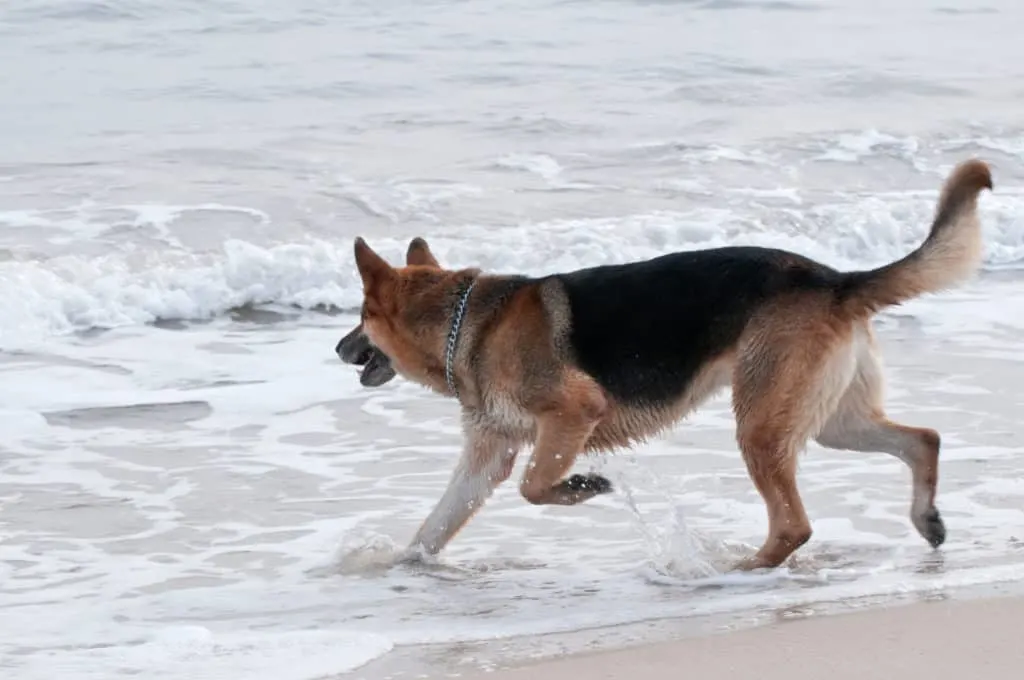
My German Shepherd used to frighten pretty easily when he was a puppy. One of his biggest fears was water.
He eventually outgrew this fear, but I thought that it would be useful to explain why this happens with some German Shepherds, and how it can be overcome.
So why are some German Shepherds afraid of water? German Shepherds, especially as puppies, are sometimes afraid of water. This is most commonly due to the dog having a traumatizing prior experience associated with water, which then develops into an ongoing fear.
In other instances, your German Shepherd may have a fear of water simply because it is a new and unfamiliar experience for it.
Most German Shepherds do not just take to water naturally.
However, with the proper patience and discipline, your German Shepherd does have the ability to learn to love water and become a cooperative bather – and even an incredibly strong swimmer.
Let’s now take a closer look at why some German Shepherds may have a fear of water and how you can prevent this in the first place.
Click Here to Jump to a Section
Experiences Which May Cause a Fear of Water
Fear of Baths
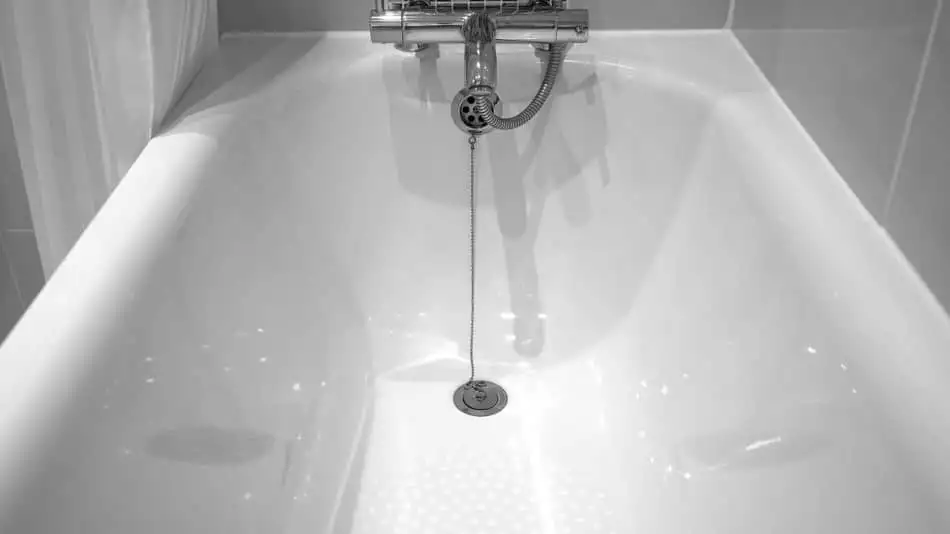
The first time you give your German Shepherd a bath, you may experience mixed results.
Some GSDs will treat water with a playful curiosity, while others may be apprehensive and show fear from the very beginning. It is important to carefully and properly acclimate your GSD to taking baths.
If this is not done properly, it can actually be a traumatic experience for your dog. This experience can potentially imprint deeply on the psyche of your dog and may last a lifetime.
So, when bathing your GSD, it’s really important to do it right. Be sure to do the following:
- Make sure that the bathtub is not slippery. Do this by placing either a towel or traction mat at the bottom of the tub.
This is crucial. GSDs have long limbs, and a slip in the tub may cause their legs to do the splits. This is not only painful for your GSD, but the resulting injury may be a serious one.
Also, placing something to give your GSD traction in the bathtub will allow it to feel confident in its footing, and both of you will have one less thing to be concerned about.
- Do not use cold water. It’s important to make bathing a pleasant experience for your GSD. Cold water can make your dog uneasy and even cause it to panic.
Instead, make sure that you bathe your GSD with warm water.
- Do not turn on the shower. It is important that your dog does not feel overwhelmed. A sudden downpour of water can be shocking to your GSD.
- Use a pet sprayer attachment. If possible, purchase a pet sprayer attachment for your faucet. This will allow you to control the force and direction of the water.
- Be careful not to spray your GSD directly in the face. Be conscious of your dog’s nose and eyes. Spraying them directly is very uncomfortable for your dog.
- Use a washcloth for your dog’s face. Also, make sure to hold it’s chin up so that all running water will drain away from its nose.
- Consider using a restraint. You may find it advantageous to use either a leash or a grooming tether. This will hold your GSD in place, and it will also make it easier for you to hold on to a slippery dog.
- Use only dog-specific shampoo. Your GSD’s skin is more sensitive than yours. So use only shampoos which are designed specifically for dogs, and which contain only natural ingredients.
- Reward your GSD both during and after. You may find it helpful to give your dog a small treat or two during the bath. This serves as both a distraction and a reward.
Additionally, it’s a good practice to give your dog a bone or some other longer-lasting chew treat after the bath is over. This associates patience in the bath with a reward to your GSD.
Fear of Bodies of Water (Pools and Open Water)
Swimming Pools
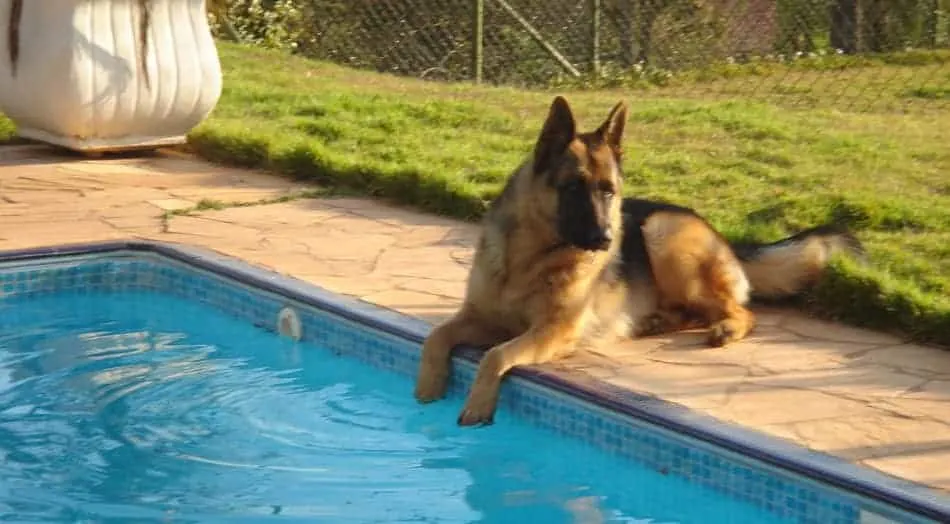
You, like me, may have learned to swim by being thrown into a pool when you were younger. This is not the approach to take with your GSD!
A swimming pool can be very intimidating for your GSD. For this reason, if you want to prevent any fear of pools from your dog, it’s important to follow these guidelines:
- Do not rush the process. Allow your dog to become familiar with the pool and surroundings on its own. If possible, take it off of the leash and let it explore on its own time.
- Do not just jump in the pool and hope that your dog will follow.
This can actually have a very negative effect on your GSD.
Since GSDs are very protective by nature, they may feel that you are in danger. This can cause your dog to panic, as its main goal is now to get you out of the water.
Try sitting on the edge of the pool with your feet in the water while your dog explores the area. This shows your GSD that the water is just another thing and not a danger.
- Limit the number of people around. If possible, keep other people around to a minimum. This will allow your dog to keep focused and calm.
- Consider using a kiddy pool. Kiddy pools are a good way to introduce your GSD to water. They are small and less intimidating to your dog.
- Consider swimming lessons for your dog. Depending on where you live, it is possible that there are dog swimming lessons available.
This can be a good option since dog pools are specifically designed for teaching dogs to swim. There is a gradual entry, and there will ideally be an instructor who is well versed in dogs that are brand new to the water.
Also, be aware that many pools have a vinyl lining. Your GSD’s claws can damage this very easily. So be sure to pick the proper pool in which to teach your GSD how to swim.
Tip: be cautious if you know that your dog loves pools. I learned this the hard way when one of my GSDs just lept into a friend’s vinyl lined pool. I had to jump in after him to prevent him from scratching the liner – that one cost me a cell phone!
Lakes and the Ocean
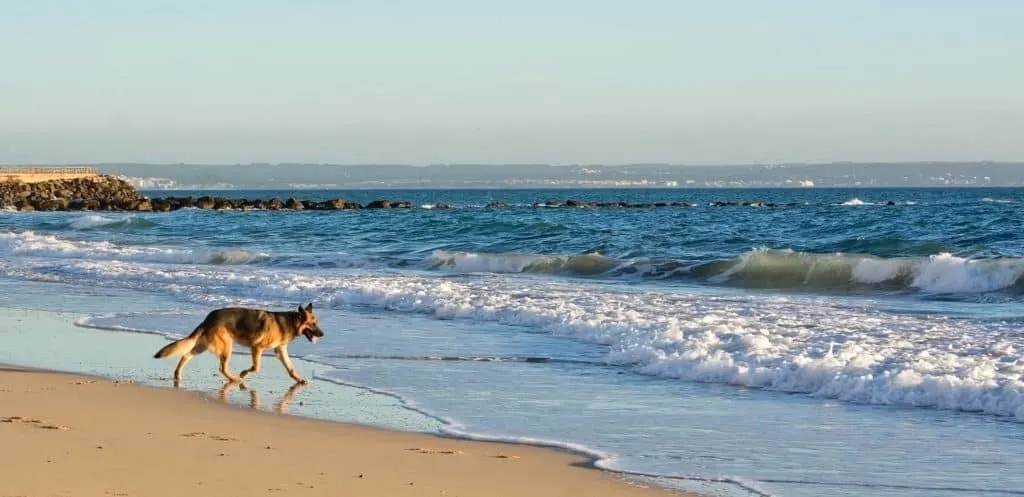
Introducing your GSD to water at a lake or in the ocean is different than a pool, and has a different set of challenges. But it also has its advantages.
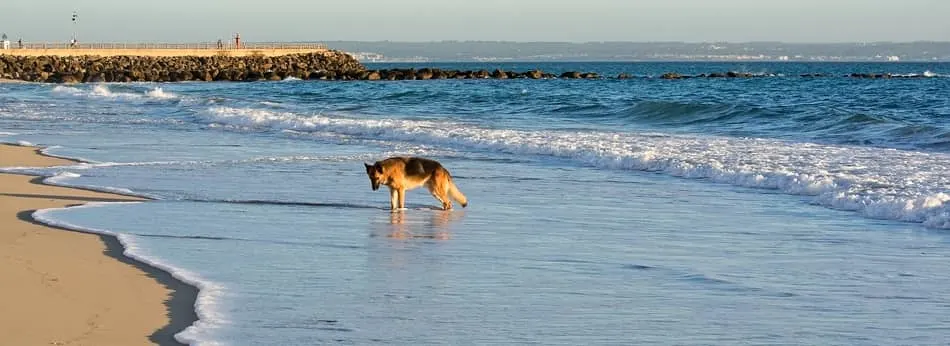
Ponds and Small Lakes
If you are able to take your GSD to a calm pond or lake, you may find that this is a better solution than a swimming pool.
This is because it is a natural environment. Your GSD will likely at least step into the water on its own out of simple curiosity. This provides a more natural and comfortable starting point than a swimming pool.
- Allow your GSD to explore on its own for a little while. From there you can aslo begin to enter the water slowly.
- Be careful not to splash your GSD. Even if you are intending it to be playful. This is a new experience for your dog, so allow it to be on it’s own terms.
Splashing your GSD with water may actually frighten it and make it apprehensive. Your GSD doesn’t see you splashing it, it just sees water attacking it!
- You should of course also be willing to get wet. It’s a good idea to slowly immerse yourself into the water – just moving deeper and deeper at a slow pace.
- Pause for a while every few steps as you go deeper. If your GSD is not following you, be sure go gently encourage it. Never be demanding with your tone or your gestures.
- Use a ball or floating toy. This is perfect if your GSD likes to fetch. Begin with throwing it on the shore. Gradually move it into the water, and allow your GSD to explore its own limits.
- Be patient. You may find that your GSD just isn’t ready for the water as yet. That’s ok. Just simply go back another day and try the same thing.
Larger Lakes and the Ocean
Introducing your GSD to a larger body of water may be more challenging.
This is for a few reasons.
- Your dog cannot see the edges of the water beyond what’s right in front of it. This can be intimidating.
- The size and sound of waves and whitewash. These can be overwhelming to your GSD. So be aware of this. It is best to not try to introduce your GSD to water on a wavy day if in a lake or ocean.
If you take your dog to swim in the ocean, be sure to limit the amount of time your dog spends in the water.
Since the ocean is saltwater, it is not safe for your dog to drink it. Your dog will naturally ingest some water, so be sure to take breaks and provide your dog with fresh water.
One of my GSDs learned to swim in Lake Michigan which often has ocean-sized waves (it’s over 100 miles across and 300 miles wide).
Throughout his life, he swam in many lakes and the ocean. Through proper acclimation, he was fearless of the water, and I was the one that had to hold him back if the waves were too big.
So in order to get your GSD to either never be afraid of water, or to overcome its fears, the keys are calm, patience, and persistence.
Never rush your GSD. Allow it to approach things at its own pace, use some of the tips I’ve provided here, and your GSD will have a great relationship with water.
Related Questions
Will drinking saltwater hurt my dog? You should avoid your dog ingesting salt water as much as possible. In small amounts, saltwater can cause what is referred to as “beach diarrhea.” But in large amounts, the ingestion of saltwater can be fatal to a dog.
Can my dog get sick from drinking lake water? Bacteria and parasites which can potentially make your dog sick are common in lake water. It is important that you check the bacteria levels before you allow your dog to swim in a lake.
